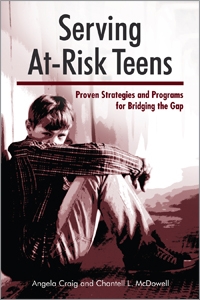Primary tabs
You don't need to be an ALA Member to purchase from the ALA Store, but you'll be asked to create an online account/profile during checkout to proceed. This Web Account is for both Members and non-Members. Note that your ALA Member discount will be applied at the final step of the checkout process.
If you are Tax-Exempt, please verify that your account is currently set up as exempt before placing your order, as our new fulfillment center will need current documentation. Learn how to verify here.
- Description
- Table of Contents
- About the authors
- Reviews
Working with at-risk teens, including those who are homeless, incarcerated, or in foster care, is a rewarding but often challenging endeavor, especially with a growing number of at-risk teens in both urban and rural areas of the country. Based on best practices and personal experiences from many leaders in the field today, including authors Angela Craig and Chantell L. McDowell, this book shows how libraries and communities can work together to find new ways to serve this population. Packed with accessible and affordable programming ideas, ready-to-use templates, and techniques, this addition to the Teens @ the Library series
- Demonstrates why serving at-risk teens is important, and offers advice for gaining institutional support for outreach services
- Shows how to understand the needs of at-risk teens, including a discussion of the factors that place teens at risk
- Examines diversity within the at-risk population
- Suggests ways to partner with youth facilities, with real-world examples of working with non-library personnel and caregivers
- Provides guidance for collection and resource development
- Gives examples of technology-based programs to promote literacy and connectedness
Check out this book's Web Extra now!
Preface Acknowledgments Introduction. Looking Beyond the Labels Chapter 1. Services for At-Risk Teens Why Serve At-Risk Teens? Advocating for Outreach Services Strategies for Gaining Support for At-Risk Initiatives Involving Library Staff: Utilizing Talent and Enlisting Reluctant Employees Strength in Numbers and Community Partners: Libraries Are Not Alone Conclusion References Chapter 2. Understanding the Needs of At-Risk Teens Developmental Needs of At-Risk Youth Supporting Teen Development The Facility Perspective The Library Perspective The Teen Perspective Conclusion References Chapter 3. Diversity within the At-Risk Population Factors That Place Teens at Risk Library Impact on the At-Risk Population Offering Support: Library Solutions Conclusion References Chapter 4. Partnering with Youth FacilitiesDifferent Types of Youth Facilities Creating Partnerships Following Youth Facility Policies Your Programs, Their Facility Working with Nonlibrary Personnel and Caregivers Forming a Lasting Partnership Conclusion References Chapter 5. Understanding the Role of Library Staff Staff Assessment: Is This Population Right for You? Librarians and Paraprofessionals: Who Is the Best Fit for Serving At-Risk Teens? Lack of Librarian Diversity Training Staying Safe Conclusion References Chapter 6. Collection Development and Resources Selection for a Select Population Developing Public Library and School Media Center Collections Developing Collections for Youth Facilities Maintaining a Mobile Collection Selection Tools Conclusion References Chapter 7. Technology Programs and Resources Starting a Technology-Based Program Promoting Literacy through Technology Use Accessing the Internet Beyond the Internet Conclusion References Chapter 8. Engaging At-Risk Teens Engaging At-Risk Teens: Programs at the Library Engaging At-Risk Teens: Programs with a Partner Facility Conclusion Reference Chapter 9. Evaluating the Impact Evaluation of Library Programs Output Measures versus Measurable Outcomes Creating and Using Measurable Outcomes with At-Risk Teens Measuring the Impact Conclusion References Appendix A. Forms Appendix B. Organizations That Serve Youth Annotated Bibliography. Core Titles for Youth at Risk Index About the Authors
Angela Craig
Angela Craig has worked with at-risk populations since 2005, and is currently Teen Services Coordinator and Teen Loft Manager for the Charlotte Mecklenburg Library of Charlotte, North Carolina. Her library programs have taken her to the county jail, alternative schools, senior centers, day care centers, homeless shelters, and public schools. She has published articles about her work with the at-risk population in Computers and Libraries and Young Adult Library Services (YALS). A conference presenter on the topic of library services to underserved populations, such as homeless patrons and youth at risk, she is currently serving on YALSA's 2013–2015 Alex Awards Committee.
Chantell L. McDowell
Chantell L. McDowell grew up as an at-risk teen, and her desire to give back to her community propelled her to a career as a librarian. While at the Brooklyn Public Library, she facilitated outreach to public and alternative schools, the Spofford Juvenile Detention Center, Rikers Island, group homes, and neighborhood clinics. Later, while serving as a Teen Services Librarian for the Charlotte Mecklenburg Library of Charlotte, North Carolina, she helped redesign the teen space of the North County Regional Library and provided special programs and services for teens at her library branch. She is currently Head Library Media Specialist at Ranson International Baccalaureate Middle School, Charlotte, and presented at ALA's annual conference in 2012 regarding library services to underserved populations.
"The authors communicate their commitment, energy and joy of achievement throughout the text. Logically sequenced instructions, sample forms, headings for writing proposals and recording program evaluations, sensible advice on plans and implementation – all combine to encourage readers to extend their services to young people at risk … recommended as a source of program ideas for young people's librarians."
--Australian Library Journal
"Highly recommended for all librarians who work with young adults."
— Public Libraries
"A recommended book that will encourage many teen librarians to begin outreach programs for at-risk teens if their library currently does not offer such services."
— Reference & User Services Quarterly



